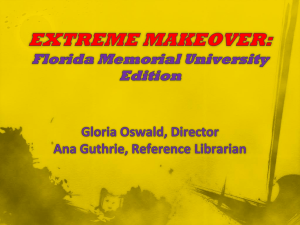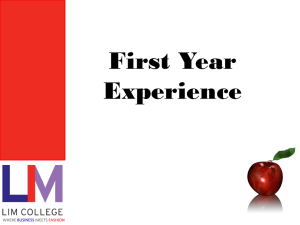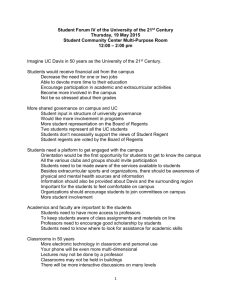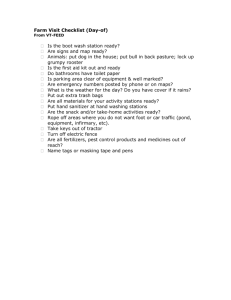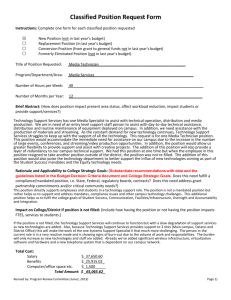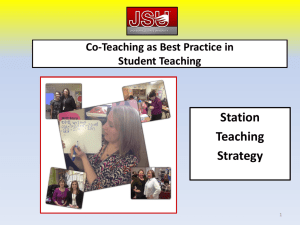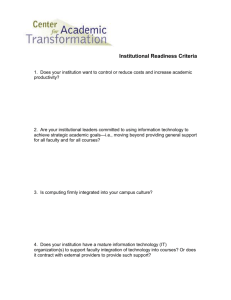COMMON (TRADITIONAL) ROTATION for LITERACY FIRST
advertisement
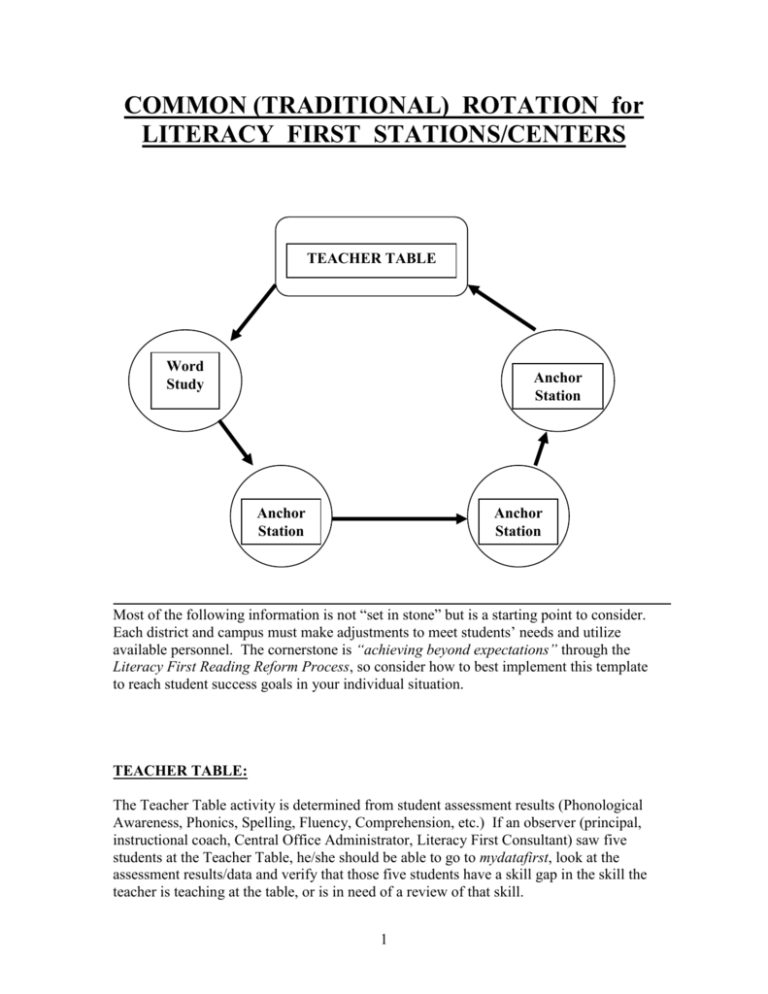
COMMON (TRADITIONAL) ROTATION for LITERACY FIRST STATIONS/CENTERS TEACHER TABLE Word Study Anchor Station Anchor Station Anchor Station Most of the following information is not “set in stone” but is a starting point to consider. Each district and campus must make adjustments to meet students’ needs and utilize available personnel. The cornerstone is “achieving beyond expectations” through the Literacy First Reading Reform Process, so consider how to best implement this template to reach student success goals in your individual situation. TEACHER TABLE: The Teacher Table activity is determined from student assessment results (Phonological Awareness, Phonics, Spelling, Fluency, Comprehension, etc.) If an observer (principal, instructional coach, Central Office Administrator, Literacy First Consultant) saw five students at the Teacher Table, he/she should be able to go to mydatafirst, look at the assessment results/data and verify that those five students have a skill gap in the skill the teacher is teaching at the table, or is in need of a review of that skill. 1 If the teacher calls three groups to the table, each group should be formed this same way so that the teacher may be teaching three different skills to three different groups of children. One group may be working in PA, while the second group is learning a comprehension skill and the third group practicing a phonics/spelling pattern. If a group is too large because more than seven students (it is not recommended to go over seven students in a group) have a gap in the same skill, the teacher could teach two groups on the same skill and one group on a different skill thus still seeing three groups. The above is a must, but let me include some areas where classroom adjustments can be made. Generally, a skill group lasts about two weeks. At the end of this time, I recommend letting the information settle a while before post-testing for mastery. This will allow the teacher to see that the skill is in memory and not just fresh on the students’ minds because they have been working on the skill for two weeks. It is not written that you must include this wait time; I have just found it to be good practice. During this period, the students have been regrouped into new skill needs (hence-flexible grouping) and may be working with completely different classmates on this new skill. Therefore, record keeping is essential so that the teacher remembers to go back and retest the students on the previous skill. Also, a student may have tested to be lacking a particular skill but once placed in the group for a couple of days he/she has this “Oh, I remember that!” moment. My recommendation is that if the teacher sees that to be the case, move the students then, not waiting for the two week period to expire, so that the child is not sitting in a group studying a skill he/she has mastery on while he/she could be learning a new skill. Additionally, some skills may not take the full two weeks, or may require even more time. This is a teacher call based on how the students are progressing. Teachers will run into situations where a child does not really fit into any of the groups. Usually this is when teachers start asking if they may “share” students. I have one student that doesn’t know short vowels, Teacher B has two that don’t know short vowels, and Teacher C has four. This is a group of seven between that grade level. For this practice we recommend each grade level have the same two hour block period. The students will stay/can stay in their own homeroom class for whole group, learning vocabulary, hearing read-alouds, practicing listening comprehension, participating in the word wall activity, etc., but at small group time, those seven students will meet with either Teacher A, B, or C to study short vowels. Since that teacher is responsible for instruction of that skill, it is my recommendation that those seven students stay with that teacher during the one hour of small group time. They will have Teacher Table, move to Word Study to do a follow-up activity, and then through the Anchor Stations in that room. When the hour is up, the students return to their own homeroom. This has proven successful in many, many schools. Grade level teachers collaborate anyway and have similar Anchor Stations so students are not “missing out” on anything. Usually in this scenario, the teacher that has taught the skill also gives the post-test when the time 2 comes, but again, that is a campus decision. Many times this practice does not start the first year because you do have to deal with a group that takes two weeks, while another takes three weeks to achieve mastery. It is workable, but during the first year it sometimes frustrates teachers to have students in different rooms for differing times. I have also seen it work beautifully in year one. Most teachers will know when this should start as it will be a help to them in planning, not “one more thing” to do. For this to work, teachers must have respect and confidence in each other. It truly is a team effort with everyone on the same page and with the same priorities. Those teachers receiving students must treat those students like their own and ensure that instruction is at the highest level. The teachers sending students must give the receiving teacher the leeway to prepare and instruct in his/her own manner and style. There is no room for conflict, finger-pointing, criticism, harsh words or hard feelings. Professionals must practice the Golden Rule and act in a manner that brings strength to the grade level and campus. I hate to have to bring it up, but I have seen a few teachers in other places act in a manner that is embarrassing as well as being harmful to the students. Yes, students pick up on teacher conflicts in a heartbeat, so there is no point to go down that road. It is important that all teachers realize we make this work together and sometimes egos have to be put away. I would not expect that behavior in your district or at your campus, but it is only fair to put out the caution. There can always be a little glitch here and a little glitch there because students do not always fall into our mold of groupings but I can tell you that this takes care of the majority of the needs and with a little problem solving by putting our heads together, the anomalies are easily settled. WORD STUDY STATION: This is the name I give to the station that reflects the skill studied at Teacher Table. Others may call it the “shadow center” or “mirror center” or something else entirely. When students are experiencing success at the Teacher Table through signaling, oral answers, or manipulating the content correctly, the activity/skill should move to the Word Study Station with the students. The teacher will want to feel confident about this success level as he/she would not want the students practicing incorrectly and then needing reteach. Since students generally do this activity unsupervised, it should be something they have previously done at the Teacher Table with help. Nothing should go to Word Study that the students have not seen before, played or done before, and had success with doing. For example, in the Phonics Activity Box, there is a game the group plays using “silent e”. I can pull that lesson and teach it probably over two days. The activity part of the 3 lesson is the game that by day three can probably go to the station with the students. I can then reinforce what I am doing at Teacher Table with “silent e” by next including the “center” activity from the box. I practice it a couple of days at Teacher Table (while students are using the first activity at station) and then switch out the new game to the Word Study Station. Each activity in the box usually has at least two lessons and one or two center activities. Don’t forget what is already on site on this skill that has been used in the past! Remember that the follow-up needs to be active participation too, so handouts only should be used occasionally. Not everything is a game, but think interactive. Again, the teacher determines the amount of time spent on an activity based on the students’ progress. Many teachers find it helpful to break down the group into pairs or trios after leaving Teacher Table. If I have six in my Teacher Table group, when I send them to Word Study there may be a board game that all six can play together or I may divide them into three groups of two to do a word sort. The station is the same for all six, but by pairing the students it often can be better managed, you hear less noise and it can be easier to monitor from Teacher Table. Another adjustment to this is on day one three students play the game together while the other three do the word sort. On day two, they switch activities. This is just an example; there are multiple activities that can be coordinated. If as the teacher I am seeing three groups, instructing three skills, I should have three activities for the Word Study Station. Not every child would do the same thing in Word Study. Each skill group would do the same thing based on the one skill studied at Teacher Table. ANCHOR STATIONS: I am giving the most flexibility in these stations this year. A common list of Anchor Stations includes Research, Listening, Alphabet, Reading/Library…. Other than in the Reading/Library Station where students need to be reading books leveled to their abilities, I am not going to be too picky about what I see. However, remember it needs to be a literacy activity. We can not do other subjects, for example math, in a center even if it is solving word problems! A center can’t just be to “color and cut out” but I would accept “color, cut out, and sequence the pictures into a story to practice retelling”! Research for kindergarten might look like giving the students cutouts of environmental print and having them sort by places to eat, things at the grocery store, etc. whereas research at third grade might have students looking at the Table of Contents in several non-fiction books of the same topic to determine what things are common and considered most important information about that topic. Fluency can be worked into most listening centers as well as listening comprehension. 4 I won’t go into much more about these stations now as I think our focus needs to remain on Teacher Table and Word Study. USE OF CERTIFIED PERSONNEL: This is an area where your district and your campus has a huge advantage. I have been playing out in my mind how to get the most benefit from this unusual situation. When I first began on campus and did not know all the players, it was hard for me to determine role responsibilities because I did not realize how many certified teachers were available. My comment that I wanted students to see their teacher everyday needs to be modified to I want students to be in a group with a certified teacher everyday. My original impression from our group discussions was that the ESL and SPED and Title paraprofessionals were coming into the classrooms to assist groups. I think that is wonderful but I just didn’t want those individuals to be held responsible for actually doing the teaching of the skill. Although I know each of the paraprofessionals is capable and certainly a value to the classrooms, legally I was uneasy about making that call. (Monitoring the Word Study Station would be great because there would be no worry of incorrect practice. Also practicing High Frequency Words would be a great help.) I understand that you also have the regular ESL, Title and sometimes SPED teachers coming into the classrooms to have small groups! I see that no differently than I would see sending students to another teacher’s classroom to learn a skill as described above. The only difference is that it is happening in the same room. In my mind, I can see for example one of the ESL teachers, taking a skill group, teaching it for two weeks, preparing the Word Study Station to follow instruction and administering the post-test (or not—be consistent with what you would do if the student is going to another room). Where I have a concern is just from a few statements I picked up on. I could have misread, but I got the impression that the special program teachers are seen in some of the regular classrooms as extra help to be supervise by the regular teacher rather than treated as another certified teacher assisting students to fill in skill gaps. I hope I am wrong about this observation. I have worked in a team teaching situation before and I would have surely been miffed if I thought my co-teacher was evaluating my performance or instructing me on how I needed to do something. Maybe I am being over-sensitive to this since my own co-teaching experience was so positive. Another concern I come back to is I want to be sure that the special program teachers do have the minutes they need with identified students. I don’t want to cause you legal concerns, but more importantly some identified students are just normally going to need more one-on-one so I am wondering if/when that can happen. 5 Additional Comments: *Work in stations does not have to be designed to be finish in one day. The teacher determines what is appropriate. *Those students that end the day at Teacher Table may need a quick review the next day at Word Study depending on if the skill is introduction, gaining mastery, or review. You may want to rotate so the same group is not last to Teacher Table every day. *Grading procedures are determined by the campus but I encourage you to be consistent at all grade levels and for sure within grade levels. *There is no set number of skill groups a teacher may see in the hour, however, three to four groups is most common due to the time allowed in the block. *Remember I gave a little “grace period” to get some testing done during Teacher Table time, but that should be rare and not part of the regular routine. I hope I have not confused anything with trying to give a clearer picture of the rotations. I know I have written a book and yet still not addressed all the questions that have come up over time. I just wanted you to have some of these points and suggestions in writing to use/distribute/discuss at collaboration meetings or faculty meetings or however you choose to disseminate information. What Literacy First looks like at a campus is not a carbon copy of another campus. Adjustments are always made and there are only a few “absolutes”. If you will stick with the non-negotiables, I’ll work with you on the modifications! 6

